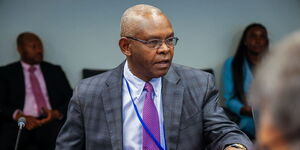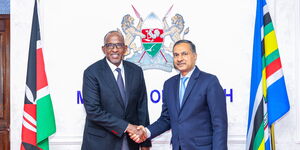African development financial institutions and leading banks have pledged Ksh12 trillion ($100 billion) towards the continent’s green industrialisation efforts, with President William Ruto playing a key role in driving the initiative.
Ruto, who chairs the Committee of African Heads of State and Government on Climate Change, witnessed the signing of the landmark agreement in Addis Ababa, Ethiopia, during the Africa Climate Summit on Monday, September 8.
The pact brings together Africa’s financial institutions, including Afreximbank, Africa50, local banks in Kenya, and the African Continental Free Trade Area (AfCFTA) Secretariat.
Together, they will channel Africa’s renewable energy wealth into building climate-smart industries, modernising value chains, and creating millions of jobs.
The agreement stemmed from the Africa Green Industrialisation Initiative (AGII), first launched at COP28 and anchored in the 2023 Nairobi Declaration at the inaugural Africa Climate Summit, and has now been transformed into a concrete action framework.
Its priorities include scaling up renewable energy-powered industrial clusters, supporting new value chains in critical minerals, green fuels and battery manufacturing, and aligning cross-border policies to boost intra-African trade under AfCFTA.
Speaking at the signing ceremony, Ruto hailed the breakthrough as proof of Africa’s determination to claim its rightful place in the global economy.
“In only a few months, we have moved from conversation to collaboration. United with our financial institutions, our energy systems, and our trade corridors, we can anchor inclusive and globally competitive green value chains,” he said.
The deal marks a shift from past reliance on foreign aid, when Africa was criticised as a passive recipient.
Further, it aims to leverage Africa's vast renewable energy potential, which a 2022 International Renewable Energy Agency (IRENA) report estimates at 1,200 GW from solar and wind alone.
The framework also complements the Accelerated Partnership for Renewables in Africa (APRA), headquartered in Nairobi, which aims to deliver 300 GW of renewable energy by 2030.
How Kenya Stands to Benefit
By hosting the AGII and APRA Secretariats, Kenya is set to benefit as Nairobi would serve as a hub for green economic activity, potentially creating thousands of jobs in renewable energy sectors such as solar, wind and geothermal, where Kenya already leads.
The deal’s focus on mobilising funds for green industrialisation aligns with Kenya’s Vision 2030, which targets a newly industrialised status by 2030. With the involvement of local banks, Kenya can finance projects such as expanding its 2,708 MW grid capacity (projected to grow to 9,790 MW under the Vision 2030 scenario) to support green manufacturing hubs.
This could boost sectors such as agriculture (climate-smart irrigation) and manufacturing, reducing the trade deficit by adding value to exports.
In addition, the involvement of local banks would enable access to concessional loans and private capital, reducing reliance on foreign aid. The funds are also expected to support climate adaptation, which is critical for Kenya, as it often faces droughts and floods.
At the same time, Africa50 announced a flagship energy infrastructure project in Kenya, valued at $313 million (Ksh40.4 billion). The deal, implemented in conjunction with the Kenya Electricity Transmission Company (KETRACO), is a public-private transmission line expected to open up renewable power for industry.
It replaces the controversial Adani deal, which Ruto cancelled last year.












